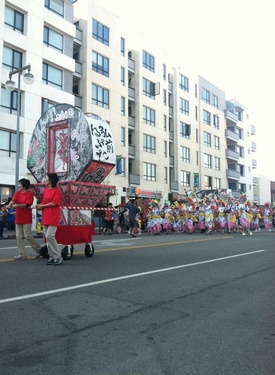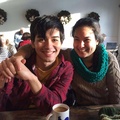Ever since I was six years old, my mom and dad always took my older sister and I to the Nisei Week festival in Little Tokyo of Downtown Los Angeles. I remember my parents buying my sister and I fresh dango and korokke for the first time from one of the many vendors lined up along the village. The sweet sauce from the dango followed by the savory tonkatsu sauce from the korokke went so perfectly hand-in-hand that it became my family’s annual snacking tradition at Nisei Week.
As my family and I roamed around the village, taking in the sights and smells, I noticed my dad greeting many other people who I did not know. I always wondered who they were and figured they were his work friends. Turns out I was half right. Some of them were work friends, but many were just friends that my dad made while working at Little Tokyo. I came to realize that everyone in the Japanese/Japanese-American community was friendly with one another, almost treating one another like family.
The opening ceremony parade was always on the first Sunday of the event. Adults, children, and elders lined up along the sidewalks of 1st and 2nd Street so the police had to shut down the streets all evening just for the parade. I remember always seeing the police and thinking how big of a deal this parade was since they had to get involved. My family and I would try to find any open spot as long as my sister and I could sit down (because we would start complaining about standing for two to three hours tops).
The parade always opened with the police of Downtown Los Angeles riding down the streets on their motorcycles followed by a series of important Japanese/Japanese-American city council members and their families perched on shiny cars.
The two floats that always caught my attention were the local Japanese/Japanese-American basketball team and the Queen and Princess Court. The basketball team always had basketball hoops that people from the crowd could try to shoot in. I never did it because I was young and shy, but I remember one of the members noticed the excitement in my eyes and handed me the basketball. I hesitated, but everyone around me encouraged me to go up and take the shot. I ended up going for it and missing. I remember my sister teasing me and feeling so embarrassed, but everyone around me clapped and said words of encouragement like “Nice try” and “It’s okay, honey.” At that moment, I instantly felt better and as if I was accepted into the community.
With the Queen and Princess Court float, seeing the queen and princesses sitting and waving from the floral-adorned float made me wish I could be a part of that group. Everytime I waved back, one of the princesses would always notice me and wave back. I remember feeling as if a celebrity had noticed me and, similar to the basketball float, I felt like I was accepted and taken into the community.
After the parade, my family always ate at Oomasa where my sister and I always shared a chicken teriyaki combination plate placed into a bento box-like plate. I never forgot my dad’s order because he always got this humongous sushi and sashimi boat that filled the table. It was always delicately decorated with flowers and bamboo leaves, and the ginger was always shaped into a pretty flower.
While growing up, the Nisei Week parade was the only time I ever really felt connected with the Japanese side of my family (My mother is Taiwanese and she had family in America so we always leaned more towards her side of the family). Every year, I always learned more and more about my identity as well as the Japanese/Japanese-American community and roots. As I grew older, I came to realize that one characteristic of the community is that it is very tight-knit. Everyone does, in fact, treat one another like family (even if they don’t know you) and everyone somehow knows one another no matter what. I came to realize this by observing from my father. He always introduced me to his friends so that everytime I came back to Little Tokyo, everyone always remembered me even if I didn’t come with my father.
Little Tokyo’s Nisei Week was the starting foundation for my interest and want to explore deeper into my Japanese side. I am taking Japanese studies and language classes at my university and joined the Nikkei Student Union organization to create a platform for voices of the Japanese-American community to share their stories with the community. I think it is important for Nisei, Sansei, and later generations to continue to learn from their older generations and pass those stories along so we do not forget where our roots came from.
© 2018 Kate Iio







